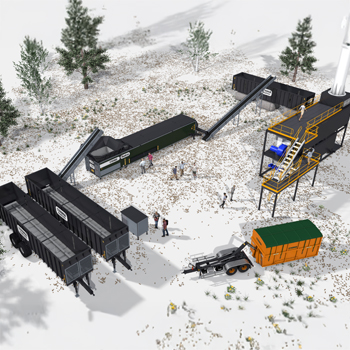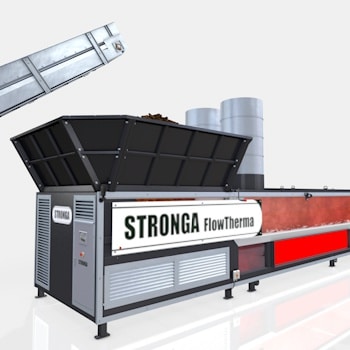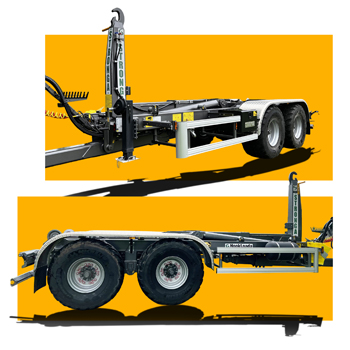Pinewood Nematode – Origin & Life Cycle
Pinewood nematode is thought to have originated in North America but has since spread to parts of Asia and Portugal. Since its outbreak in Portugal in 1999, pine wood nematodes have continued their destruction in the region and spread to Madeira, central Portugal and Spain.
Pinewood nematode is a tiny worm-like creature spread from a Monochamus pine beetle, ‘sawyer’ species. The beetles lay eggs in the bark of pine trees and the bacteria carried by the nematode reacts with endophytic bacteria found in the pine species, attacking bark and accelerating tree decay, causing pine wilt and diminishing the value of the pine. After the nematode attacks, infected trees will display vastly different physical properties, including discolouration, which ‘de-values’ the timber, and also yellowing pine needles. This makes the tree ‘unusable’ and causes it to die within a couple of months of infection.

Controlling the Spread Remains a High Priority
Given the rate of egg production (female nematodes can produce up to 150 eggs in a short 28-day cycle) and adult development (eggs can develop into a reproductive adult within 4 days), it is no wonder how pinewood nematodes have the potential to cause catastrophic damage to forest land. Controlling the spread remains a high priority on an international scale.

Nematode Problem, Solved?
It is widely acknowledged that the main cause of pinewood nematode spread is transporting infected timber. Felling, de-barking and burning remain the main control methods for areas where the nematode is active. While these offer an effective method of eradication, they also offer no economic or environmental benefit; instead, negatively impacting habitats and landscapes. The problem is there is a surplus of felled, infected timber and bark which has no value or export potential because of the restrictions placed on infected pinewood nematode timber products, considered a quarantine pest in over 40 countries.
The focus for those in the timber industry is how can value be reintroduced into nematode-infected pinewood while complying with strict import/export restrictions? The answer is through phytosanitary measures which enable timber companies who sterilise pine bark to export it as a high value, pathogen-free product. Clean bark products are valuable commodities with numerous utilities as fuel, soil improvers, nuggets, peat substitutes and mulch or for ornamental purposes.

Steam Sterilisation vs Methyl Bromide
Chemicals such as methyl bromide* and ineffective biological pesticides have been used in the past to control the spread of pine wilt nematode. Now, steam sterilisation is more heavily utilised because it offers a more environmentally and financially suitable control process. Steam sterilisation offers full eradication of the pathogen and far safer operating conditions, posing no risk to the ozone and environment.
* In 2010 all uses of methyl bromide were banned in the EU, including for quarantine and shipping uses.

Portugal’s Pine Problem
Pinewood nematode was first introduced to Portugal in the 90s through the importation of infected timber. It has since caused catastrophic damage to pine forests, negatively impacting the country’s potential income from pine products. In an attempt to eradicate pine wilt nematode, Portugal has spent close to €80 million but the majority of forests are privately owned, meaning forest owners are responsible for the control of the pathogen on their land.
Due to the nature of transmission, countries without pinewood nematode remain on high alert and will ‘intercept’ pine trade imports from affected countries, preventing any risk of non-autochthonous pathogen spread. Steam sterilising infected wood and bark ‘by-products’ provides those areas affected with significant financial benefits. Through steam heat-treatment sterilisation using the FlowSteama system, bark products are transformed from having no value into clean, saleable, revenue-producing resources.

Compliance with Phytosanitary Requirements
Steam sterilising pine bark allows forest owners (in Portugal and beyond) to comply with strict phytosanitary requirements and international laws which consider bark and wood imports from ‘conifer (pinales)’ as ‘high-risk’. The costs associated with non-compliant exportations and import rejections are largely the importer’s responsibility. Providing certification is displayed (and this can be evidence via the FlowSteama HMI), bark products can flow across borders and, at current market prices, unlock valuable opportunities for the whole supply chain.

Steam Powers Waste Reduction
Steam sterilisation is central to extracting value from nematode-infested pine bark. It offers a lower cost, less toxic, environmentally-friendly alternative to controlled-burning and chemical sterilisation. Research carried out by Serra, Santos, Fonseca and Abrantes, endorsed by the LNEG scientific production (National Laboratory of Energy and Geology), shows that steam possesses the qualities required for effective elimination of pine wood nematode.
Conclusive, rigorous tests carried out by the group in 2012; compare the ability to eradicate pine wood nematode in sensor laden bags of pine wood and bark within a continuous bulk process, using varying temperatures of steam. Using temperature probes, bags containing bark were tested at a range of temperatures between 75.6’C – 93.4’C for 30-minute treatments. The presence of pine wood nematode was tested immediately on half the bags, these bags showed a 0% presence of pine wood nematode. The other bags were tested after a 15-day incubation period at 25’C, these research results were also successful and proved steam sterilisation successfully eradicated 100% of all present nematode organisms.
Make a Powerful Investment
Stronga’s FlowSteama heat-treatment solution allows pinewood nematode infected bark to be recycled and re-used as a valuable resource. The FlowSteama ‘Rova’ model is a mobile in-vessel steam system that uses low pressure, 200’C super-heated steam to sterilise bark material. The equipment enables operators to maintain strict hygiene protocols when sterilising infected bark and has designated “clean” and “dirty” sides, avoiding risks of cross-contamination.
FlowSteama also enables clients to evidence residency-time logging with multiple temperature sensors located at various intervals along the vessel, as well as data logged on the HMI touchscreen. This provides operators with confirmation that temperature and residency time parameters have been achieved, allowing them to remain bio-secure in an industry with strict compliance polices.

Stronga Bark Sterilisation Results
Stronga has many years of experience in sterilising bark material and has carried out thorough research on the ability steam has to penetrate and disinfect bark. Our own testing of fine and medium grade bark uncovered that coarser bark absorbed steam at a slower rate than finer material, but was still able to reach the required 80’C+ temperature of material, which was tested on exit. Different grades of bark have different temperature and steam requirements and these can be discussed with our technical team at point of enquiry.
Stronga engineers have methodically designed the FlowSteama to ensure it is as efficient and long life as possible. The in-built PulseWave™ system automatically agitates material in the vessel, ensuring the whole load is fully mixed and penetrated with steam. Stainless steel components ensure the equipment performs reliably for multiple years while our special primer, shot-blast and painting process enables our team to achieve the signature silver finish on all steel parts.

There are a number of features that contribute to making FlowSteama the market’s leading steam pasteurisation system. Below is a short summary of the benefits customers value most:
- Extremely low maintenance requirements with a simple but effective design.
- Excellent cost-efficiency. Energy recuperation can be considered as a way of improving efficiency further.
- Easy to install. With an uncomplicated design, FlowSteama can be up and running in a matter of days, allowing customers to maintain production demands.
- Flexible across materials. Although FlowSteama is designed to deal with material set-out in the initial consultation, it is capable of sterilising a wide range of materials from bark to soil, compost, manure and more.
- Highly-effective. The dual-deck in-vessel system enables super-heated steam penetration through the entire load.

Reliable Pinewood Nematode Removal
Sterilising bark with FlowSteama is a highly effective method of removing all traces of pinewood nematode, injecting significant value into infected bark. The costs associated with exporting non-regulatory bark are huge; turn residue into revenue today; speak to Stronga – info@stronga.co.uk
Bibliography:
Serra, C.; J. A. dos Santos; L. Fonseca; I. Abrantes. Coniferous bark heat treatment for the elimination of the pinewood nematode by continuous hot steam system. In: SCPH, Brussels, November 22-23, 2012 https://repositorio.lneg.pt/handle/10400.9/1583



Share this post